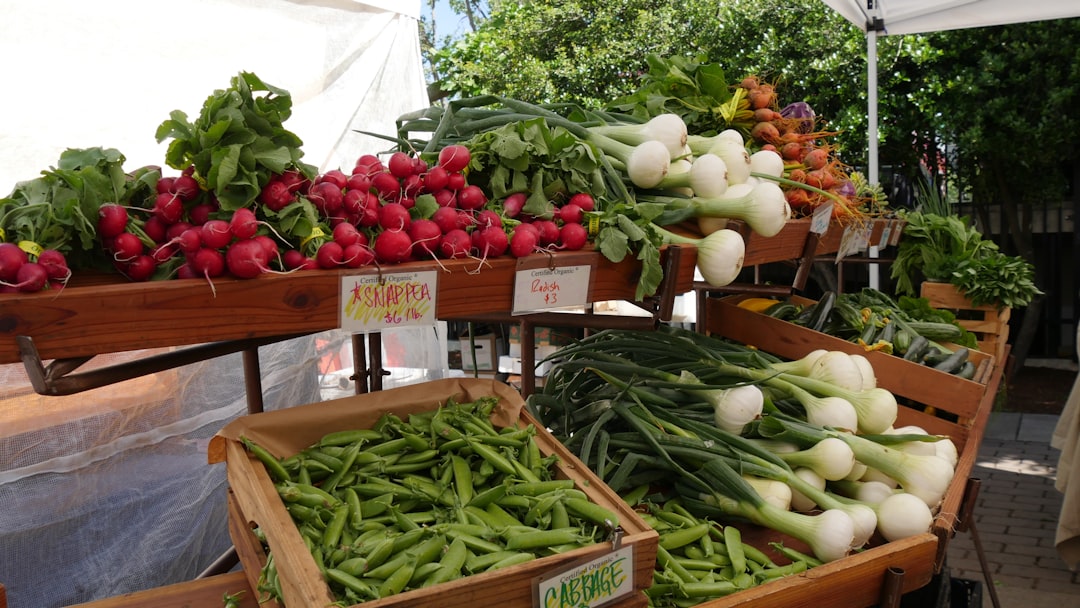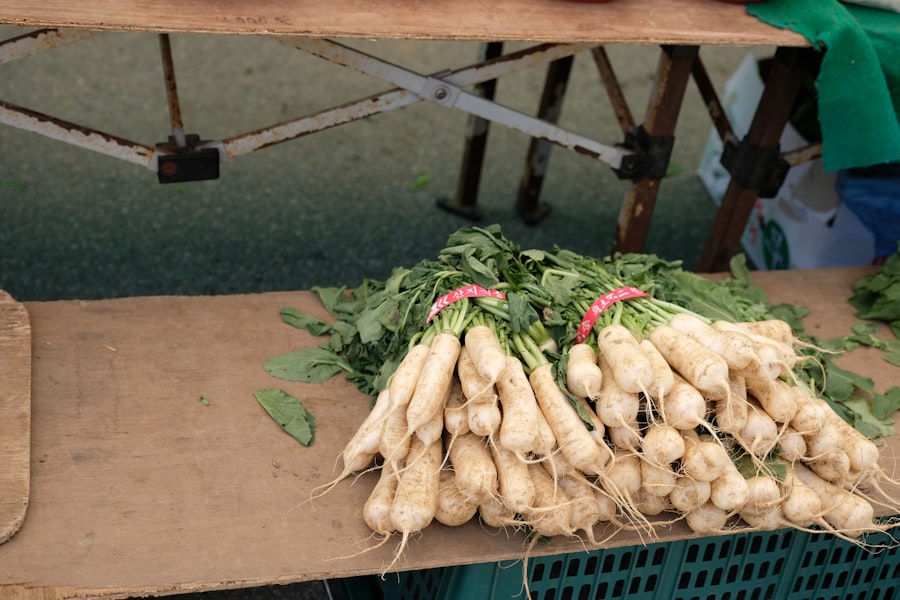Growing Radishes: From Seed to Harvest in Just 3 Weeks

Radishes are a versatile and easy-to-grow crop that can be a great addition to any garden. They are a member of the Brassicaceae family, which also includes cabbage, broccoli, and kale. Radishes are known for their crisp texture and peppery flavor, making them a popular choice for salads and other dishes.
One of the main benefits of growing radishes is that they have a short growing season, typically taking only 3-4 weeks from planting to harvest. This makes them an ideal choice for beginner gardeners or those who want to see quick results. Additionally, radishes can be grown in containers or small spaces, making them suitable for urban gardens or those with limited space.
Key Takeaways
- Radishes are a quick and easy crop to grow.
- Different types of radishes have varying growing requirements.
- Preparing the soil is crucial for successful radish planting.
- Best practices for sowing radish seeds include proper spacing and depth.
- Caring for radish plants involves proper watering, fertilizing, and pest control.
Understanding the Different Types of Radishes and Their Growing Requirements
There are several different types of radishes, each with its own unique characteristics and growing requirements. The most common types include round radishes, long radishes, and winter radishes.
Round radishes, such as Cherry Belle and French Breakfast, are the most popular variety and are known for their small, round shape. They have a mild flavor and can be harvested in as little as 20 days.
Long radishes, such as Daikon and White Icicle, have an elongated shape and can grow up to 18 inches long. They have a milder flavor compared to round radishes and take slightly longer to mature.
Winter radishes, such as Black Spanish and Watermelon, have a larger size and take longer to mature compared to other varieties. They are typically planted in late summer or early fall and can be stored for several months.
When choosing the right type of radish for your garden, consider factors such as the length of your growing season, available space, and personal preference for flavor and texture.
Preparing the Soil for Radish Planting: Tips and Techniques
Proper soil preparation is essential for the successful growth of radishes. Radishes prefer loose, well-draining soil with a pH level between 5.8 and 6.8. Before planting, it is recommended to test the soil to determine its pH level and nutrient content.
If the soil pH is too low, adding lime can help raise it to the optimal range. On the other hand, if the pH is too high, sulfur can be added to lower it. Additionally, incorporating organic matter such as compost or well-rotted manure into the soil can improve its structure and fertility.
To prepare the soil for planting, start by removing any weeds or debris. Then, use a garden fork or tiller to loosen the soil to a depth of at least 6 inches. This will help improve drainage and allow the radish roots to penetrate easily.
Sowing Radish Seeds: Best Practices for Successful Germination
| Best Practices for Sowing Radish Seeds | Metric |
|---|---|
| Seed Depth | 1/4 inch |
| Seed Spacing | 1 inch apart |
| Soil Temperature | 50-65°F |
| Germination Time | 3-10 days |
| Watering | Keep soil moist, but not waterlogged |
| Light Requirements | Full sun to partial shade |
| Fertilization | Apply balanced fertilizer before planting and again after seedlings emerge |
| Harvest Time | 20-30 days after planting |
When it comes to sowing radish seeds, there are a few best practices to follow for successful germination. First, select high-quality seeds from a reputable supplier. Look for seeds that are plump and free from any signs of damage or disease.
Before sowing the seeds, it is important to prepare the planting area by raking the soil smooth and creating shallow furrows. The depth of the furrows should be about half an inch deep.
To sow the seeds, sprinkle them evenly along the furrows, leaving about an inch of space between each seed. Then, lightly cover the seeds with soil and gently firm it down.
Factors that can affect germination success include temperature and moisture levels. Radish seeds prefer cool temperatures between 50-65°F (10-18°C) for optimal germination. Additionally, keeping the soil consistently moist but not waterlogged is important for seed germination.
Caring for Radish Plants: Watering, Fertilizing, and Pest Control
Proper care is essential for the healthy growth of radish plants. One of the most important aspects of care is watering. Radishes require consistent moisture to prevent them from becoming woody or developing a bitter taste. It is recommended to water radish plants deeply once or twice a week, depending on the weather conditions.
Fertilizing radish plants can help promote healthy growth and improve yields. Before planting, it is beneficial to incorporate a balanced fertilizer into the soil. Additionally, side-dressing with a nitrogen-rich fertilizer halfway through the growing season can provide an extra boost of nutrients.
Radishes are generally resistant to pests and diseases. However, there are a few common pests that can affect them, such as flea beetles and root maggots. To control these pests, it is important to practice good garden hygiene by removing any plant debris and keeping the garden area clean. Additionally, using row covers or applying organic insecticides can help prevent pest infestations.
Managing Radish Growth: Thinning, Weeding, and Pruning

Thinning radish plants is an important step in managing their growth. When the seedlings have grown to about 2 inches tall, thin them out to provide enough space for each plant to grow. This will help prevent overcrowding and allow the radishes to develop properly.
Weeding is another important aspect of managing radish growth. Weeds can compete with radish plants for nutrients and water, so it is important to keep the garden area weed-free. Regularly inspect the garden for any weeds and remove them promptly.
Pruning is not typically necessary for radish plants. However, if the leaves become overcrowded or start to shade the developing radishes, it may be beneficial to remove some of the leaves to allow more sunlight to reach the radishes.
Harvesting Radishes: When and How to Pick Your Crop
Knowing when to harvest radishes is crucial to ensure that they are at their peak flavor and texture. Most radishes can be harvested when they reach their mature size, which is typically indicated on the seed packet. However, it is also important to pay attention to other signs of readiness, such as the color and firmness of the radishes.
Round radishes are usually ready to be harvested within 20-30 days after planting. They should be firm and have a bright color. Long radishes take slightly longer to mature, usually around 30-40 days. Winter radishes can take up to 60 days or more to reach maturity.
To harvest radishes, gently loosen the soil around the base of the plant using a garden fork or trowel. Then, grasp the radish near the top and pull it out of the ground. Be careful not to damage the roots or leaves.
Storing and Preserving Radishes: Tips for Keeping Them Fresh
After harvesting radishes, it is important to store them properly to keep them fresh for as long as possible. Start by removing any excess soil from the radishes, but avoid washing them as moisture can cause them to spoil faster.
To store radishes, trim off any greens and place them in a perforated plastic bag or a container with a lid. Store them in the refrigerator crisper drawer, where they can stay fresh for up to two weeks.
If you have an abundance of radishes and want to preserve them for later use, there are a few methods you can try. One option is pickling, which involves soaking the radishes in a vinegar-based brine. Another option is freezing, which involves blanching the radishes before placing them in freezer-safe containers.
Creative Ways to Use Radishes in Your Cooking: Recipes and Ideas
Radishes can be used in a variety of ways in cooking, adding a crisp texture and refreshing flavor to dishes. Here are a few ideas and recipes to inspire you:
– Radish Salad: Thinly slice radishes and toss them with mixed greens, cucumber, and a simple vinaigrette for a refreshing salad.
– Radish Salsa: Finely chop radishes and mix them with diced tomatoes, onions, jalapenos, lime juice, and cilantro for a zesty salsa.
– Radish Slaw: Shred radishes and cabbage, then toss them with mayonnaise, vinegar, sugar, and salt for a tangy slaw.
– Roasted Radishes: Toss whole radishes with olive oil, salt, and pepper, then roast them in the oven until they are tender and slightly caramelized.
– Radish Butter: Mix finely chopped radishes with softened butter, salt, and herbs for a flavorful spread.
Troubleshooting Common Problems in Radish Growing: Solutions and Fixes
While radishes are generally easy to grow, there are a few common problems that can arise. Here are some tips for identifying and solving these problems:
– Slow or uneven germination: This can be caused by factors such as low soil temperature or poor seed quality. To improve germination rates, ensure that the soil is warm enough and use high-quality seeds from a reputable supplier.
– Bolted radishes: Bolting occurs when radish plants prematurely produce flowers and seeds. This can be caused by high temperatures or stress. To prevent bolting, plant radishes in cooler weather or provide shade during hot periods.
– Root maggots: These pests can damage the roots of radish plants. To control them, practice good garden hygiene by removing any plant debris and using row covers to prevent infestations.
– Cracked or split radishes: This can occur when there is fluctuation in moisture levels. To prevent cracking, ensure that the soil is consistently moist and avoid overwatering.
If you encounter any other problems or need further assistance, there are many resources available online and at local gardening centers that can provide additional troubleshooting and support.
If you’re curious about how long it takes radishes to grow, you might find this article on Lawn World quite helpful. They have a comprehensive guide on growing radishes, including information on the ideal conditions, planting techniques, and estimated timeframes for different radish varieties to reach maturity. Check out their article here for all the details you need to know about growing your own delicious radishes. And if you’re looking for more gardening tips and resources, don’t forget to explore Lawn World’s sitemap for a wealth of information.
FAQs
What are radishes?
Radishes are a root vegetable that belongs to the Brassicaceae family. They are usually eaten raw and have a crisp texture and a slightly spicy flavor.
How long does it take radishes to grow?
Radishes typically take 3-4 weeks to grow from seed to harvest. However, this can vary depending on the variety of radish and the growing conditions.
What are the ideal growing conditions for radishes?
Radishes prefer cool temperatures and moist soil. They can be grown in full sun or partial shade and require well-draining soil.
Can radishes be grown year-round?
Radishes can be grown year-round in some regions, but they are typically grown as a cool-season crop in the spring and fall.
What are some common varieties of radishes?
Common varieties of radishes include Cherry Belle, French Breakfast, Easter Egg, and Watermelon. Each variety has a slightly different flavor and appearance.
How are radishes harvested?
Radishes are harvested by pulling them out of the ground by the leaves or by using a garden fork to loosen the soil around the roots. They should be harvested when they are mature but still small and tender.



